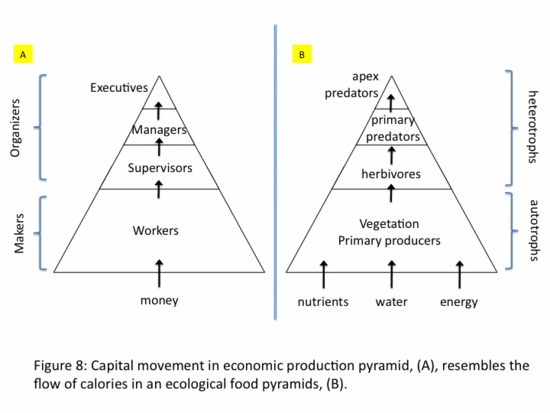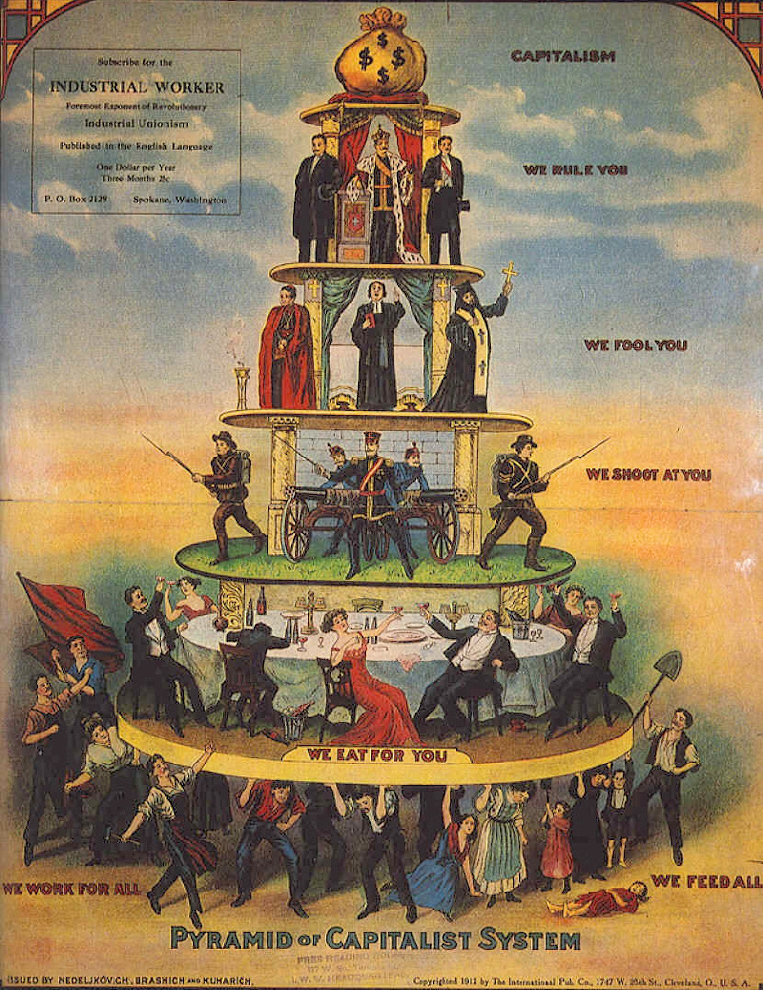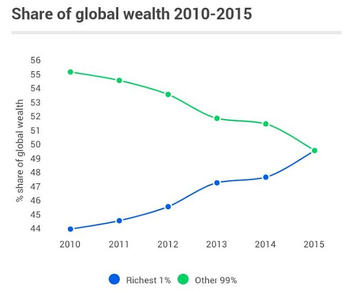
The Pyramid of Capitalism is a notion that was popularized in the 1910s. It began as an illustration that depicted the underlying structure of their economy which, as the term suggests, has a pyramid-like flow of wealth that results in a vast concentration within the top region, representing the smallest population group. The lower you go, the more thinned-out it becomes, going from government, to church, to military, and finally at the bottom is the working class. Making up the majority of the population, yet holding the lowest amount of wealth, the original cartoon caricature was critical of this inequality.
In it’s essence, capitalism depends on the transaction of something at a higher cost than what it was previously attained for. Without capital profit, such an economic system would not be able to exist. Given those terms, it is only natural that the form of the economy will increasingly be narrowing out; as more value is generated, the amount of exploitation also increases. This is the entropy of our modern economy.
In it’s essence, capitalism depends on the transaction of something at a higher cost than what it was previously attained for. Without capital profit, such an economic system would not be able to exist. Given those terms, it is only natural that the form of the economy will increasingly be narrowing out; as more value is generated, the amount of exploitation also increases. This is the entropy of our modern economy.


Many have compared this structure to a natural food chain. There is a small amount of apex predators at the top who are free to consume as much prey as they can catch without worrying about being caught themselves. And like the pyramid of our society, this top-tier is followed by less privileged groups, leading all the way down from carnivores to invertebrates.
However, this comparison to the animal kingdom is not completely analogous to us. Apex predators have unquestionable physical advantages (size, power, speed) from all other groups beneath them. The difference between each trophic level is determined primarily, if not entirely, by an animal’s physical traits in relation to hunting and catching prey. This is a significant factor because in our pyramid, there is no natural pre-determined boundary of rank. Although there are separate wealth classes, each with their own signifiers and criteria, the status of a person is not determined by their physical qualities, but rather their supposed value. The higher up you go, the more value is being generated.
What I find interesting is the thought of intrinsic value being different than the precievable value of what somebody can contribute to society. In order to agree with the narrowing form of capitalism, there has to be the assumption that as you go down each trophic level, the people residing are of less qualification and/or less potential. Otherwise, the division of wealth would be unjust. If we’re entering an age where technology creates abundance from scarcity, what happens if the innate value is reversed? What happens when the resources of the few are accessible to everyone? When the barrier to entry is lowered? When those who occupy the lower levels have the most to offer?
However, this comparison to the animal kingdom is not completely analogous to us. Apex predators have unquestionable physical advantages (size, power, speed) from all other groups beneath them. The difference between each trophic level is determined primarily, if not entirely, by an animal’s physical traits in relation to hunting and catching prey. This is a significant factor because in our pyramid, there is no natural pre-determined boundary of rank. Although there are separate wealth classes, each with their own signifiers and criteria, the status of a person is not determined by their physical qualities, but rather their supposed value. The higher up you go, the more value is being generated.
What I find interesting is the thought of intrinsic value being different than the precievable value of what somebody can contribute to society. In order to agree with the narrowing form of capitalism, there has to be the assumption that as you go down each trophic level, the people residing are of less qualification and/or less potential. Otherwise, the division of wealth would be unjust. If we’re entering an age where technology creates abundance from scarcity, what happens if the innate value is reversed? What happens when the resources of the few are accessible to everyone? When the barrier to entry is lowered? When those who occupy the lower levels have the most to offer?